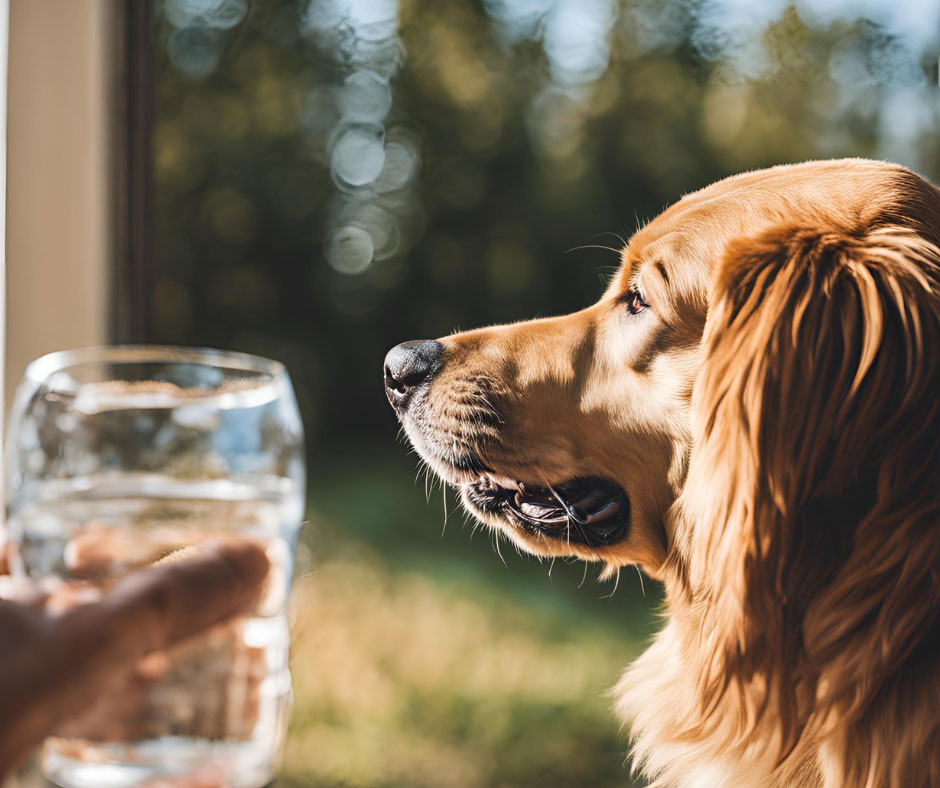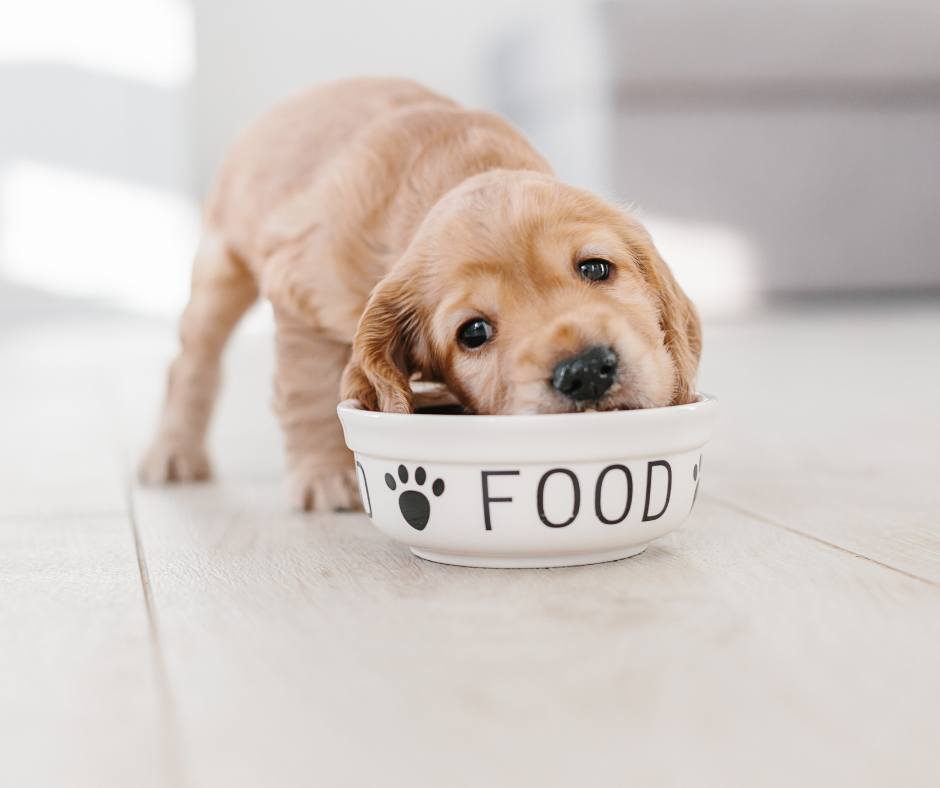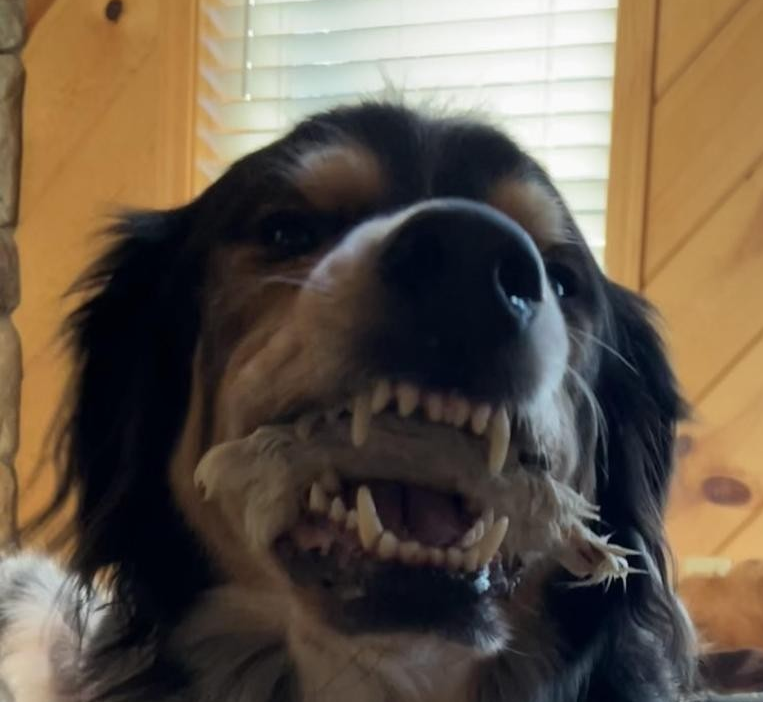
Should you give your dog a bone?
The short answer is yes, probably. The long answer is still yes, but with a bit more detail. Lets start with a short story.
The photo above is my dog Copper, and as you can see, he has excellent teeth. They’re white! They’re straight! They’re healthy! My opinion is that he was blessed with great teeth because, well, he’s a knucklehead with minimal brains, and nature always balances itself out somehow. On the other hand, my husband’s dog, Piper, had absolutely terrible teeth when we first met. She was 5 at the time, terrified of a toothbrush, had visible plaque and tarter, foul breath that could melt your eyebrows off, and red swollen gums. I knew that she was headed for a dental cleaning at best, and at risk for severe health conditions such as heart disease, endocarditis, sepsis, stroke, kidney disease or even death at worst. At this time, she was kibble fed and ate Greenies dental treats a few times a week. Her history as a rescue had left her with anxiety and brushing her teeth just wasn’t an option.
So what did I do? First, we switched to fresh food and tossed the Greenies into the trash like the garbage they were. After checking that all her teeth were stable (nothing was loose, cracked or showing signs of a deep infection), I began feeding her raw meaty bones, or RMBs. She took to them like she was born for it, which, of course, she was! After a year of doing NOTHING other than feeding a species appropriate diet with RMBs, her red and swollen gums had returned to normal, the tarter flaked away, and her breath became your typical, healthy doggie breath. No dental cleaning. No tooth brushing. No additional products. I can say with absolute certainty that RMBs saved her from needing an anesthetic dental cleaning, which is not without risk. And it certainly saved her from the complications associated with advanced dental disease, which are many and can be devastating.
Now that you know a little bit about my own dogs’ experiences, how a species appropriate diet improved their lives, and the reason why I’m so passionate about sharing this with you all, lets really get down and dirty discussing bones and their place in diet of our furry friends.
Myths vs Facts
If you simply type “are bones safe for dogs” into an internet search, you will invariably be told NO NO NO! Here are a few myths that the deep, dark internet will try to scare you with:
- Bones splinter and will damage the intestines
- Bones are indigestible and will cause a blockage
- Bones can damage teeth
And whats reeeeeeally crazy about all of those statements is…. they’re all true! But only IF you change the wording:
- Cooked bones splinter and can damage the intestines
- Cooked bones are indigestible and can cause a blockage
- Inappropriately sized or dense bones can damage teeth
So you can see that nuance is important here, because it’s easy to scare someone into not feeding this component of a species appropriate diet, and that’s a shame. I want to expand even further on each of those above points and show you why RMBs are the way to go.
- Raw meaty bones (RMBs) are cushioned by meat, connective tissue and cartilage minimizing the risk of breaking in a way that causes sharp splinters.
- RMBs are moist and able to be broken down by the stomach acid, so by the time they enter the colon they’re almost completely liquified and don’t lead to a blockage.
- You should match the size of the dog to the size and density of the bone to protect the teeth. For example, a slab of pork ribs is appropriate for a Husky but not a Chihuahua! Likewise weight bearing bones such as femurs should generally be avoided because they’re too dense to properly consume. The dog below is holding a bone that is both too large and too dense for him- a recipe for disaster!
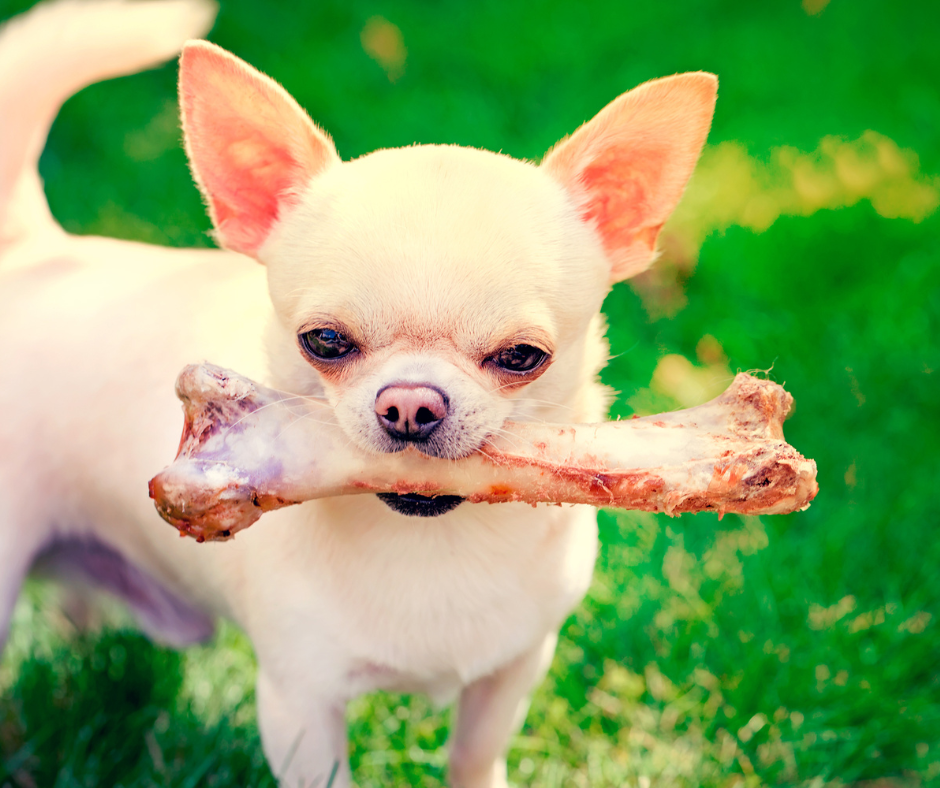
Of course the biggest myth of all time is that crunchy kibble cleans teeth. THIS IS AN OUTRIGHT LIE and the kibble companies and treat companies (like Greenies, which are literally toothbrush shaped potato chips) know it. Our vets, sadly, have been taught this lie by kibble reps, and often also believe it even though there is absolutely zero evidence to support it, and mountains of evidence to show that exactly the opposite is true- kibble is the number one cause of dental disease in pets.
Now you know what is a truth, what is a myth, and what is absolute bullsh*t. Next up is the why and the how!
Why should you feed bones?
There are many reasons! As I already explained in my own dog’s journey, feeding RMBs have excellent benefits for the teeth. Chewing on and consuming bones does actually scrape the plaque off the teeth and/or any other foreign materials from the teeth that could get stuck there and start to feed the bacteria in the mouth which is what leads to the development of plaque (specifically carbohydrates, because bacteria eat sugar).
Another excellent reason is because it helps strengthen the head, facial and neck muscles. These muscles don’t really get a workout when dogs eat kibble. The method of consuming dry food essentially consists of dogs using their tongue and lower jaw as a chute to just shovel the food into the mouth and swallowing it with maybe a crunch or two at most. This doesn’t allow for actual chewing, grinding, and working of all these muscles like having to really work at a RMB does. And without proper and frequent use, these muscles will atrophy, or get weak, and start to waste away with age.
One more very important benefit is the release of serotonin! Yes, chewing on RMBs actually makes dogs happy! Unlike people, chewing and licking helps release happy hormones for our pets, and acts as enrichment. This is important, because obviously we all want our fur babies to be both healthy and happy. I love that RMBs check both of those categories.
When should you NOT feed bones?
There aren’t too many cases where I’d recommend staying away from feeding raw meaty bones in whole form. Overall, the benefits are too great for me to go “eh, it doesn’t really matter, you do you!” Instead, I look for a few specific criteria before I say perhaps this isn’t the best choice for your pet. Those include:
- Pets with extensive broken or missing teeth: unfortunately, you do need at least SOME teeth to safely chew on a RMB. Broken teeth or loose teeth require a dental appointment, because not only are they painful, they can lead to infection. So of course we want to avoid RMBs if you see this in your pet’s mouth. However missing teeth can also be a problem because then your dog can’t crunch the bone into a suitable shape to safely swallow it. A dog with missing teeth may still be able to safely and lightly chew on a recreational bone not meant for chewing (more on that below), but likely not an intact RMB for consumption
- Pets who gulp: gulpers can be hard to train and difficult to deal with. We all know a gulper- the dog who will snatch anything you drop or hand over as a treat and literally swallow it whole, sometimes choking in the process. This could be for many reasons- fear or anxiety (I must eat it before it gets taken away!), overexcitement (this is so good I have to consume it now now NOW!), or resource guarding (this is MINE, and if anyone comes near I’ll immediately swallow it so they can’t have it). Some of these can be managed and trained, but it requires patience, and sometimes special tools that prevent the gulping from occurring. If you aren’t able to do this training and your dog is a gulper, for safety reasons it may be better to avoid RMBs.
How does one begin feeding RMBs?
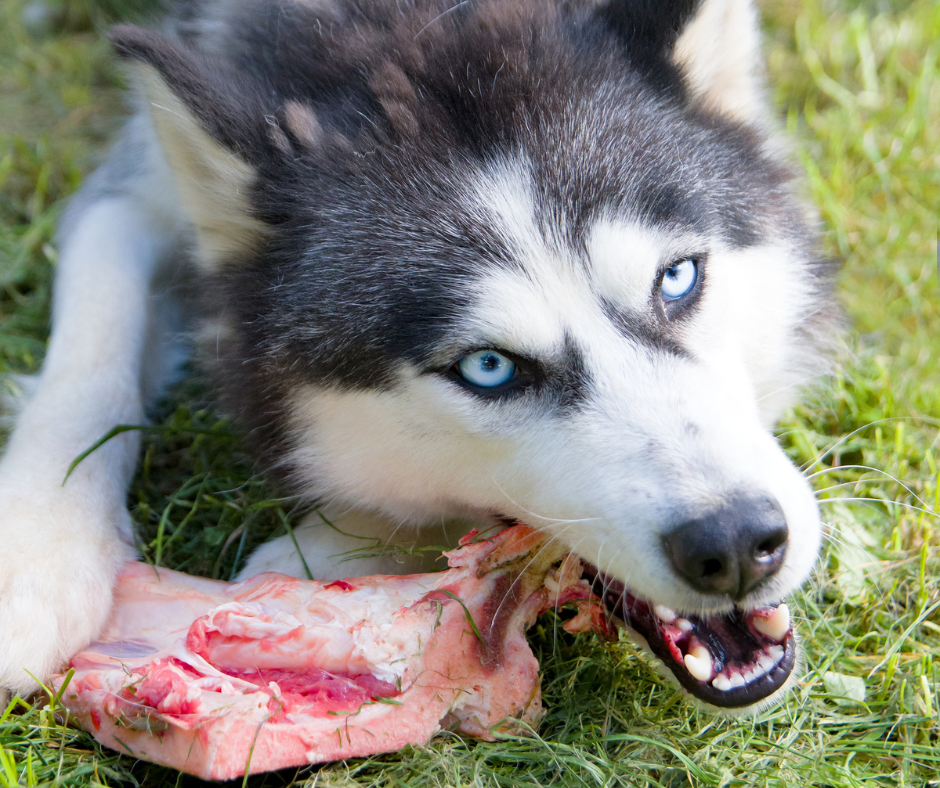
There are a few methods you could choose from when it comes to RMBs. First, though, I hope you’ll look at the photo above and think “what’s wrong with that bone…?” based off of what I said in the myth vs fact section (I hope you were paying attention!).
When I first gave my dogs bones, I set a plate of chicken feet on the ground, backed up a few steps, and then physically restrained myself from snatching them back up before the dogs could eat them. Honestly, I was terrified. I, like many others, had first asked the internet if bones were safe and was of course told no. Then raw feeding groups convinced me it was actually safe. But I still had to break past that barrier in my mind of the 30 years I had thought the opposite and convince myself I was not about to kill my dogs. I’m so glad that I did, because it completely changed their lives for the better, and we’ll never go back!
These are the considerations when you’re choosing a bone for your dog:
- Match the size of the bone to the size of the dog.
- You can feed a Chihuahua a duck foot. You can also feed a Great Dane a chicken foot if he’s going to crunch it a few times. However while you can feed a Dane a slab of ribs, you cannot do the same for a Chihuahua. This is one time that size really does matter 😉
- Know their chewing style.
- My dogs range from 35lbs to 65lbs, but because of their jaw strength and chewing styles, they can all eat the same types of bones from the duck foot to the pork ribs. However, if my 65lb dog was more of a gulper, he wouldn’t be able to safely eat duck feet and would need to be given a bone that is slightly larger than the size of his mouth to encourage him to chew it into a shape suitable for swallowing. When in doubt, choose something a little larger so they have to chomp once or twice. Once you know how they chew, you can give smaller bones with confidence. Here, bigger is better!
- Make sure they feel safe.
- My smallest dog has issues with resource guarding. She will happily chew on a RMB without a care in the world, but if one of the other dogs comes over to her while she’s eating, she will immediately swallow it even if it’s still too big for comfort. Because of this, she gets fed in a separate part of the yard to keep her feeling safe and thus eating safely as well. Other options may include placing in a separate room, a closed crate, or at separate times of the day.
- Be patient!
- It might sound silly, but some dogs literally have no idea how to eat a raw meaty bone after years of eating kibble. Sometimes play can help with this, which can be a little gross if you’re handling a duck foot and trying to initiate a game of tug-of-war, but just wash your hands afterward and you’ll be fine. Play, patience and encouragement go a long way, and even the most knuckleheaded dogs (like mine!) will get there in the end.
Are there alternatives?
Yes. If, after this blog, you still don’t feel comfortable feeding bones or you have a dog who can’t safely eat them, there are some other options for you.
First, you can feed ground bone. Premade raw foods grind bones anywhere from thumb-nail sized chunks to powdered, which removes the need for the dog to chew a bone. This of course removes the dental benefits, but you’re still feeding a species appropriate diet which is important.
Another option is to use bone replacement. I only recommend this if there’s no way to grind the bone yourself or use a premade, because ground bone and whole RMBs are superior to bone replacements. Some options include Buck Bones, Better Bones, and Eggshell powder. Eggshell should never be used as a primary calcium/bone replacement source for puppies.
What about treats?
I love giving my dogs chews as treats. I give them their RMBs as a part of their meal, but I will occasionally give an air dried or freeze-dried meaty bones as a special treat or for enrichment. My favorite company for air dried meaty bones is Real Dog Box. They have a unique air-drying technology that doesn’t raise the temperature to the point where the matrix of the bones become brittle, allowing them to stay very digestible and decreasing the risk of splintering. They have an excellent subscription service where you can choose the animal protein, the size of the bone, with fur or without, and even add things on like a Super Chew or grab something rare from their Secret Shop. I’m a huge fan and have been using their services for about three years now.
I generally avoid weight bearing bones, smoked bones, dehydrated bones, antlers and yak chews. Antlers are extremely dense- as dense as a cow femur. I have seen many accounts of these breaking teeth and will not use them or recommend them. The same goes for yak chews- they’re dense, they oxidize, and I’m just not a fan. Marrow bones that you can buy at the store and both machine cut and weight bearing (they’re femurs!), so those are also a no for me. While some dogs might just like to lick the marrow out of the middle, this is also not a favorite pastime as that’s a lot of fat in a short amount of time and can lead to some diarrhea. Save those for making bone broth instead. Smoked bones are carcinogenic, and dehydrated bones are at a higher risk of splintering.
And please, PLEASE do not give Greenies or any of those other crappy ‘dental treats’ on the market. They don’t clean teeth- they cause tooth decay. I don’t care what kind of clever marketing they use or how many AI photos of dogs smiling with a shiny set of dentures they slap on their bags- just say no. Reach for something real and species appropriate instead. Your dog will thank you.
Uh, hey, you forgot about the cats?
Whoops! Here’s the thing about kitties and bones… mine are veeeeeery picky and it took quite a while to even get their geriatric fluff butts onto raw. Bones are still a no in our house for the cats, with the exception of one who enjoys air dried chicken wing tips. So I don’t have any words of wisdom for you on cats in terms of getting them to start eating bones if they’ve gone a lifetime without them. Mine are still looking at me like I’ve sprouted another head every time I try.
However, if you’re lucky enough to have a kitten starting out on raw, or an older cat who is more adventurous and will accept RMBs, then there are some great options for you. Chicken wing tips, as mentioned, are a good choice. Whole quail, mice, and chicks make for wonderful whole prey meals. Some rabbit bones may work, and Guinea fowl feet as well. Cats are masters at consuming entire small animals, so if you can find those then you’re golden.
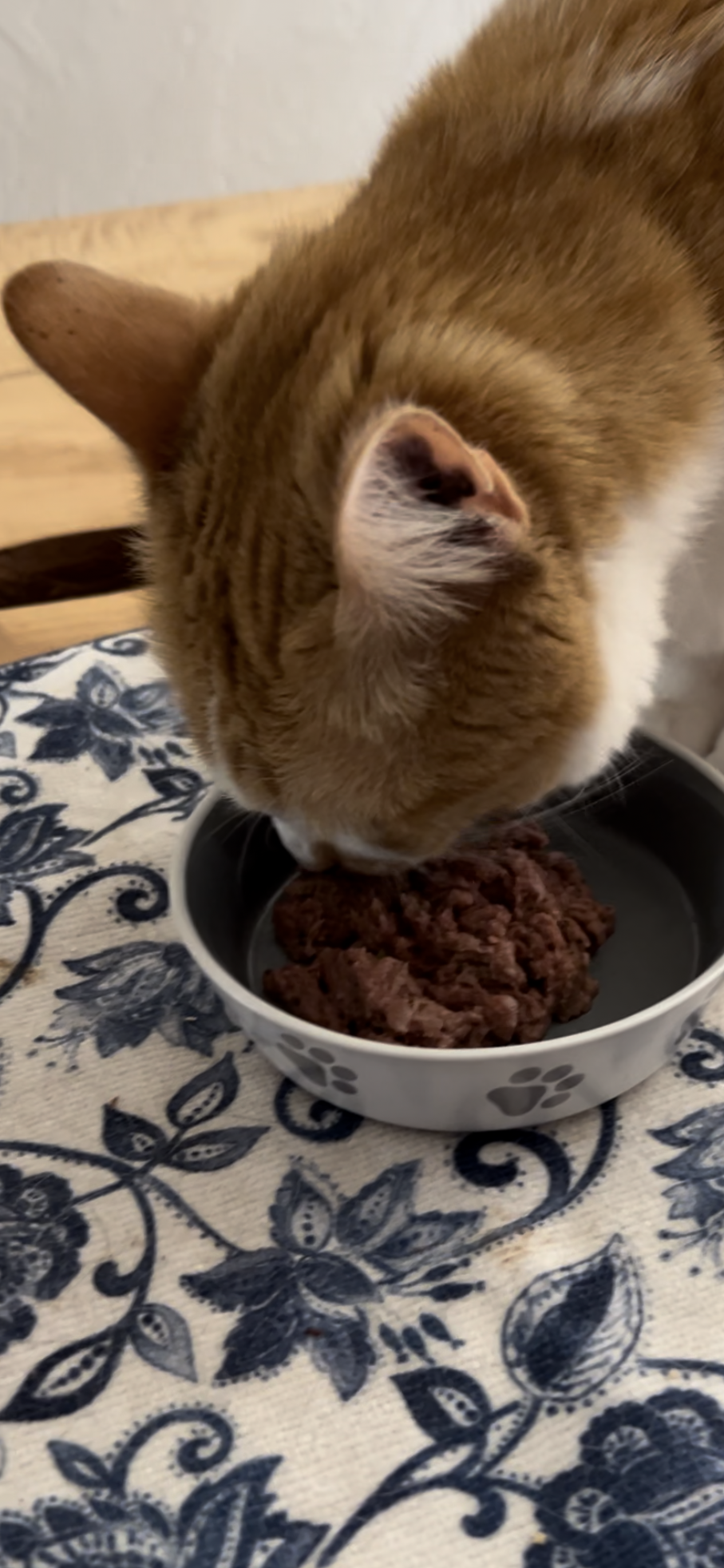
Oliver, my chicken wing eating ginger, says thank you for reading, and we’ll see you next time!

